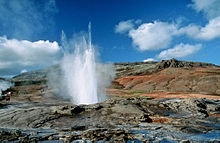Great geyser
The Great Geyser ( isl. Stóri Geysir , [ ˌstouːrɪ ˈceiːsɪr ]) is a geyser in southern Iceland in the municipality of Bláskógabyggð .
The term geyser is derived from the Icelandic word geysa " splash out, pour out" (which in turn is the frequentative of the verb gjósa "gush, break out"), was coined in the 17th century and generally designates geothermal springs of a similar type as they are in other parts became generally known to the world only in the 19th century.
The Great Geyser was first described as an appearance in the 13th century, making it the oldest known geyser and occasionally still active.
The volcanic system in the geothermally very active area of Haukadalur at the foot of the Laugarfjall lava dome in the south of the island is named after him.
To the Geysir volcanic system
The volcanic system in Haukadalur consists of an eroded central volcano made of basalt rock and lava domes made of rhyolite from the Pleistocene . No eruptions were detected in the volcanic system after the Ice Age , but it is still active.
The high temperature area is approx. 500 m long and 100 m wide. It seems to have been much larger in the past, as the silicate slabs typical for covering spring springs cover an area of 200,000 m 2 .
functionality
How a geyser works has long been unexplained. It was not until 1846 that Robert Bunsen was able to explore the geyser on a trip to Iceland and explain its function scientifically.
Spring springs, which are called geysers, arise when they have a relatively narrow eruption channel. Leachate heated by magma is heated to well over 100 ° C without boiling due to the pressure of the water column in the eruption canal. Individual bubbles rise and force some of the water out. This causes the pressure to drop and the superheated water suddenly turns into water vapor, which presses the remaining liquid water up through the gap. Such an eruption can throw the water up to 100 meters into the air.
In the case of the Great Geyser , a hot water flow with a temperature of 127 ° C could be determined as a source approx.
history
The Great Geyser was mentioned for the first time in 1294 in the so-called Oddsverja annáll , when a strong earthquake shook the previously known sources of the Haukadalur and significantly changed the geological activity. In 1647 it was first described by the bishop Brynjólfur Sveinsson under the name Geysir . As early as the 17th century it was recognized that the activities of the spring spring must be directly related to earthquakes. In 1845 it reached a height of 170 meters. Its eruptions mostly reached heights of up to 60 meters.
From 1915 the Great Geyser stopped its activity. It was not until 1935 that he became active again for a few years and then slept for longer periods of time.
In the 1970s it was made to break out as a tourist attraction with the help of many kilograms of soft soap, which could take over a day depending on the weather. This measure was later limited to the first weekend in August (merchant weekend). Under pressure from environmental protection associations, this was also abolished in the early 1980s.
It has been active again since an earthquake in 2000, but it only erupts irregularly. Between June 17 and 20, 2000, the geyser reached a height of 122 meters for two days and is considered the highest geyser. The height of its eruptions is now only up to 10 meters, but with an extended eruption duration.
In the wake of the financial crisis, Iceland's economy has turned more to tourism. In the 1990s, it was only possible to reach and visit the great geyser with a twice daily omnibus. Now it is one of the main goals of the Icelandic tourism industry and is part of the so-called Golden Circle . Numerous large car parks, outlet stores, lodges and souvenir shops have been added.
Other well-known springs in Haukadalur (South Iceland)
A few meters away from him are the regularly active Strokkur geyser and other spring springs such as Smiður and Litli Geysir (The Little Geyser) as well as a large number of other hot water springs, such as Blesi .
See also
Web links
- Geysir the Global Volcanism Program of the Smithsonian Institution (English)
Individual evidence
- ↑ Alexander Jóhannesson: Icelandic etymological dictionary. Bern 1956. p. 316.
- ↑ Sabine Barth: Island , Dumont Reiseverlag, 2010, p. 170.
- ↑ Great Geyser in the Global Volcanism Program of the Smithsonian Institution (English) Accessed: May 23, 2010.
- ↑ Íslandshandbókin. 2. bindi. 1989, p. 790.
- ↑ The name "Geyser" is not mentioned there.
- ↑ Sabine Barth: Island , Dumont Reiseverlag, 2010, p. 170.
- ↑ Íslandshandbókin. 2. bindi. 1989, p. 790.
Coordinates: 64 ° 18 ′ 52 ″ N , 20 ° 18 ′ 3 ″ W.






